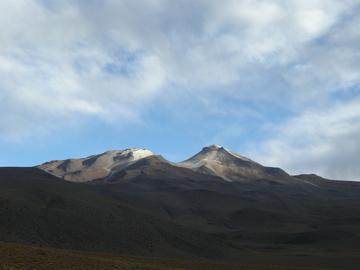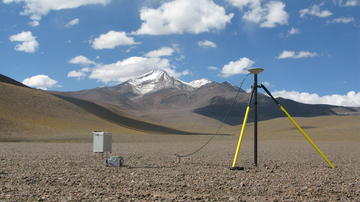Anatomy of a “zombie” volcano: investigating the cause of unrest inside Uturuncu

Cerro Uturuncu, one of many volcanoes on the Bolivian Altiplano that lie above the Altiplano-Puna Magma Body. Photo credit Jon Blundy, University of Oxford
Scientists from China, the UK and the USA have collaborated to analyse the inner workings of Bolivia’s “zombie” volcano, Uturuncu. By combining seismology, physics models and analysis of rock composition, researchers identify the causes of Uturuncu’s unrest, alleviating fears of an imminent eruption. The findings were published today in the journal PNAS.
Deep in the Central Andes lies Uturuncu, Bolivia’s “zombie” volcano -so called because despite being technically dead (last erupting 250 thousand years ago), it still shows signs of unrest, including earthquakes and plumes of gases. This unrest manifests itself in a “sombrero” pattern of deformation, with the land in the centre of the volcanic system rising up, and surrounding areas sinking down.
For the local population, it is vitally important to assess the potential start and severity of an eruption from Uturuncu, which could cause widespread damage and threat to life. However, up to now there was no explanation for the continued volcanic unrest. Scientists believed that the key to understanding this was to visualise the way that magma and gases move around underneath the volcano.
This new study, which drew upon expertise from University of Science and Technology of China, the University of Oxford and Cornell University, used signals detected from more than 1,700 earthquake events to perform high-resolution imaging of the plumbing system in the shallow crust beneath Uturuncu. According to the findings, the “zombie”-like unrest of Uturuncu is due to the movement of liquid and gas beneath the crater, with a low likelihood of an imminent eruption.
I am very pleased to be involved in this truly international collaboration. Our results show how linked geophysical and geological methods can be used to better understand volcanoes, and the hazards and potential resources they present.
- Professor Mike Kendall (Department of Earth Sciences, University of Oxford), Study Co-Author

Gravimeter and GPS station with Cerro Uturuncu in the background. Photo credit Duncan Muir, Cardiff University
Volcanic plumbing systems are a complex mixture of fluids and gases in magmatic reservoirs and hydrothermal systems. Previous studies have shown that Uturuncu sits above the world’s largest known magma body in the Earth’s crust, the Altiplano-Puna Volcanic Complex, and that an active hydrothermal system connects this body and the surface. But it was unknown how fluids may be moving through this underground system.
The research team made use of seismic tomography, a way of imaging the interior of the volcano, similar to methods used in medical imaging of the human body. Seismic waves travel at different speeds through different materials, thereby providing high-resolution insights into the inner workings of Uturuncu in three dimensions. They combined this with analysis of the physical properties of the system, including rock composition, to better understand the subterranean volcanic system. This detailed analysis picked out possible upward migration pathways of geothermally heated fluids and showed how liquids and gases accumulate in reservoirs directly below the volcano’s crater. The research team believe that this is the most likely cause for the deformation in the centre of the volcanic system, and that the risk of a real eruption is low.
Professor Haijiang Zhang (School of Earth and Space Sciences, University of Science and Technology of China), one of the study's co-authors, said: "Understanding the anatomy of the Uturuncu volcanic system was only possible thanks to the expertise within the research team. This enabled us to combine various advanced geophysical imaging tools with modelling of the rock properties and their interactions with fluids."
The research team hope that similar studies using the joint analysis of seismological and petrological properties can be used to view the anatomy of other volcanic systems in the future.
The methods in this paper could be applied to the more than 1400 potentially active volcanoes and to the dozens of volcanoes like Uturuncu that aren't considered active but that show signs of life — other potential zombie volcanoes.
- Professor Matthew Pritchard (Cornell University), Study Co-Author
The study ‘Anatomy of magmatic hydrothermal system beneath Uturuncu volcano, Bolivia, by joint seismological and petrophysical analysis’ was published today in the journal PNAS, and is available to read at https://doi.org/10.1073/pnas.2420996122.




